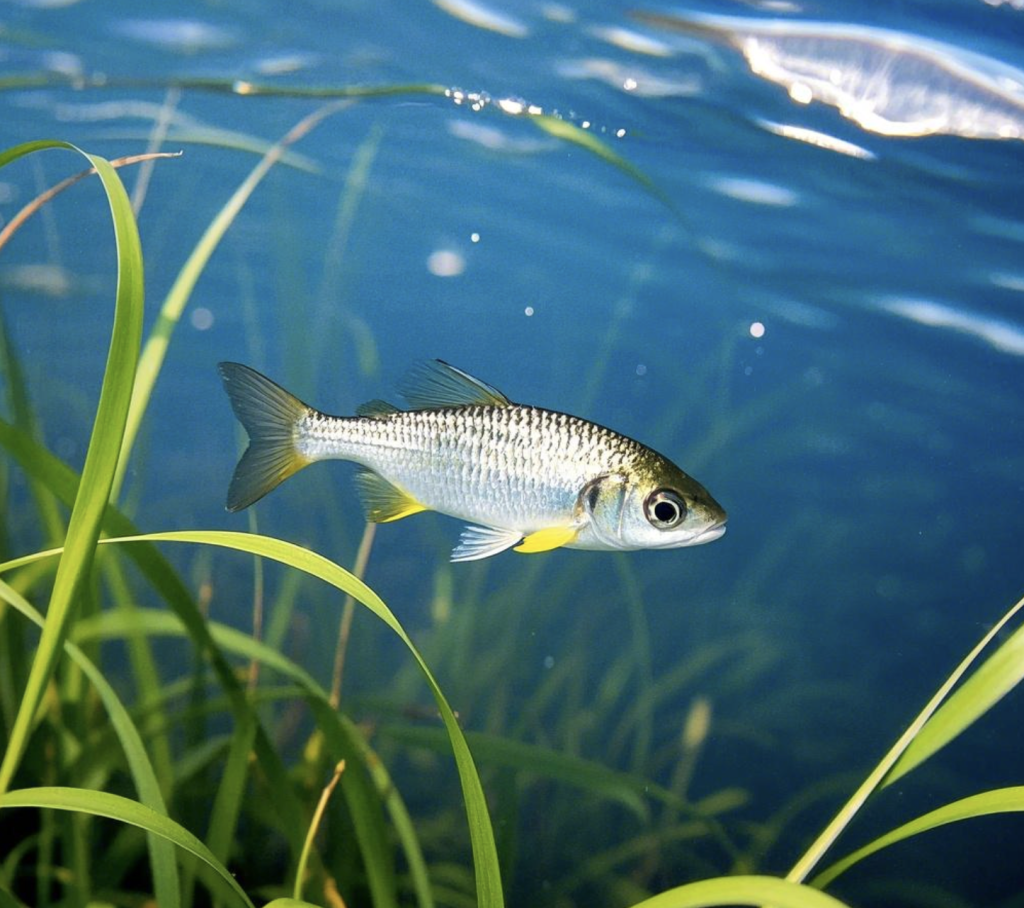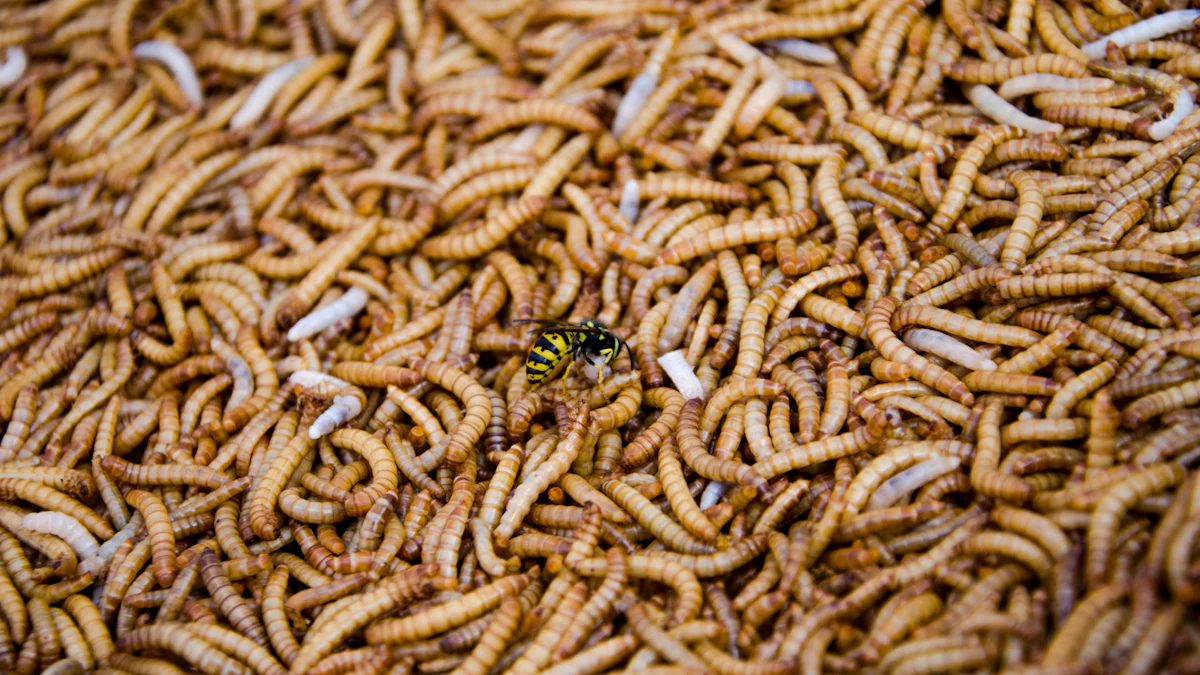
Have you ever wondered if your fish could benefit from a special treat? I’ve found that dried mealworms for fish are not only safe but also incredibly nutritious. Packed with protein, healthy fats, and essential vitamins, they help boost energy, enhance vibrant scales, and support overall health.
Here’s something fascinating: dried mealworms contain more calcium, magnesium, and potassium than eggs! These nutrients are vital for strong bones, metabolic processes, and bodily functions. Plus, they mimic natural feeding habits, which keeps fish happy and healthy.
All our mealworms meet FDA standards and come with a Veterinary Health Certificate. You can shop confidently, knowing you’re getting high-quality options at great prices. We offer various package sizes to suit your needs. Feel free to contact us with questions or leave a review—we’d love to hear from you!
Key Takeaways
- Dried mealworms are a healthy snack for fish. They have protein, good fats, and important vitamins for growth and health.
- Giving dried mealworms once or twice a week is best. This keeps their diet balanced and avoids problems like weight gain.
- Soaking mealworms before feeding helps fish digest them better. This is especially helpful for smaller fish to get all the nutrients.
Nutritional Benefits of Dried Mealworms for Fish
Protein for Growth and Energy
When I first started feeding dried mealworms to my fish, I noticed a big difference in their energy levels and growth. These little treats are packed with protein—about 48% to 54%, which is higher than many other fish foods. This protein helps fish build muscle and maintain their energy throughout the day.
Here’s what makes the protein in dried mealworms so special:
- It supports muscle development, which is crucial for growing fish.
- It provides energy to keep them active and healthy.
- It includes essential amino acids, except methionine, making it a well-rounded option for fish diets.
If you’re wondering how dried mealworms compare to other fish foods, take a look at this:
| Food Source | Protein Content (%) |
|---|---|
| Dried Mealworms | 48% – 54% |
| Common Fish Foods | Varies (generally lower) |
Healthy Fats for Vibrancy and Stamina
I’ve also seen how the healthy fats in dried mealworms can make a difference. These fats, which make up about 30% of the mealworms, are essential for fish health. They help fish develop vibrant scales and maintain stamina.
Here’s why these fats are so beneficial:
- They contain omega-3 and omega-6 fatty acids, which support healthy skin and scales.
- They promote brain function and reproductive health.
- They help fish combat stress and adapt to environmental changes.
Tropical fish, like cichlids, thrive on these fats. I’ve noticed brighter colors and more lively behavior in my fish after adding dried mealworms to their diet. It’s amazing to see the difference!
Vitamins and Minerals for Immune Support
Dried mealworms for fish aren’t just about protein and fats—they’re also loaded with vitamins and minerals. These nutrients play a huge role in boosting fish immune systems and overall health.
Some of the key vitamins and minerals include:
- Vitamin B12: Essential for immune function.
- Iron and Zinc: Strengthen bones and improve oxygen circulation.
- Calcium and Magnesium: Support bone health and biochemical reactions.
- Selenium: Acts as an antioxidant, helping fish fight off illnesses.
Here’s a quick breakdown of the nutrients:
| Vitamin/Mineral | Description |
|---|---|
| Vitamin B12 | Boosts immune function and overall health |
| Iron | Improves oxygen circulation and bone strength |
| Zinc | Supports immune health |
| Calcium | Vital for strong bones |
| Magnesium | Aids in biochemical processes |
| Selenium | Antioxidant that enhances immunity |
Adding dried mealworms to your fish’s diet ensures they get a variety of nutrients, reducing the risk of deficiencies. I’ve found that my fish are healthier and more resilient since I started feeding them these treats.
How to Feed Dried Mealworms to Fish
Proper Portion Sizes and Frequency
When feeding dried mealworms to fish, portion size matters. I’ve learned that larger fish, like cichlids, can handle whole mealworms without any trouble. For smaller fish, I always cut the mealworms into tiny, bite-sized pieces. This makes it easier for them to eat and reduces the risk of choking.
I also keep an eye on how much my fish eat. If there are leftovers floating around, I remove them right away. Uneaten mealworms can affect water quality, and no one wants that! As for how often to feed them, I stick to once or twice a week. This keeps their diet balanced and prevents overfeeding, which can lead to health problems.
Preparing and Soaking Mealworms
Before feeding dried mealworms to fish, I always prepare them properly. For smaller fish, I cut the mealworms into small pieces. Then, I soak them in water for a few minutes. This softens the mealworms, making them easier to digest.
For larger fish, I sometimes offer whole mealworms. Soaking still helps, though, as it mimics the texture of live food. It’s important to remember that dried mealworms should complement your fish’s main diet. I mix them with pellets or flakes to ensure my fish get all the nutrients they need.
Tips for Introducing Mealworms to Fish
Introducing dried mealworms for fish can be exciting, but it’s important to go slow. I start by offering a small amount and watching how my fish react. Some fish might refuse the mealworms at first, which is normal. Gradual introduction helps avoid digestive issues.
I also pay close attention to their behavior. If I notice any signs of distress, like unusual swimming patterns or refusal to eat, I stop feeding and reassess. Over time, most fish warm up to mealworms and even look forward to them as a treat!
🐟 Pro Tip: Always observe your fish after introducing new food. It’s the best way to ensure they’re happy and healthy.
Types of Fish That Benefit from Dried Mealworms

Carnivorous and Omnivorous Fish
I’ve noticed that carnivorous and omnivorous fish thrive when I add dried mealworms to their diet. Carnivorous species like oscars and arowanas benefit greatly from the essential fatty acids in mealworms. These nutrients help them build strong muscles and maintain their energy for active lifestyles. Plus, I’ve seen their colors become more vibrant, which is always exciting to watch!
Omnivorous fish, like goldfish and mollies, also enjoy the balanced nutrition that dried mealworms provide. The protein and healthy fats in mealworms support their growth and keep them healthy. I’ve found that these fish are naturally drawn to the texture and flavor of mealworms, making feeding time a breeze.
🐟 Fun Fact: Many fish, including opportunistic feeders like bettas and cichlids, love the crunch and taste of dried mealworms. It’s like a gourmet treat for them!
Aquarium Fish That Enjoy Mealworms
If you’re wondering which aquarium fish enjoy dried mealworms, here’s a quick list based on my experience:
- Goldfish
- Bettas
- Cichlids
- Oscars
- Arowanas
These fish not only enjoy mealworms but also benefit from the nutrients they provide. For example, cichlids, which are known for their love of insects, get a boost in energy and growth from mealworms. I’ve seen my goldfish and bettas eagerly gobble them up too!
| Fish Species | Dietary Preference |
|---|---|
| Goldfish | Enjoys dried mealworms |
| Bettas | Enjoys dried mealworms |
| Cichlids | Enjoys dried mealworms |
| Oscars | Enjoys dried mealworms |
| Arowanas | Enjoys dried mealworms |
Pond Fish and Their Dietary Needs
Pond fish, like koi and other outdoor species, also benefit from dried mealworms. These treats mimic the insects they’d naturally find in the wild, making them a perfect addition to their diet. I’ve noticed that the protein in mealworms helps with muscle development, while the healthy fats keep their scales shiny and vibrant.
Here’s why I think dried mealworms are great for pond fish:
- They provide essential vitamins like B12, iron, and zinc, which promote overall health.
- They help replicate a diverse diet, reducing the risk of nutritional deficiencies.
- They’re easy to store and feed, making them a convenient option for pond owners.
All of our mealworms meet FDA standards and come with a Veterinary Health Certificate. You can shop confidently, knowing you’re getting high-quality options at great prices. We offer a range of package sizes to suit your needs. Feel free to contact us with any questions or leave a review—we’d love to hear from you!
Potential Drawbacks and Considerations
Risks of Overfeeding
Overfeeding dried mealworms can cause more harm than good. I’ve learned that treating mealworms as a primary food source disrupts a balanced diet for fish. This can lead to health problems like obesity or digestive issues. I always remind myself to feed mealworms in moderation.
Here’s why overfeeding can be risky:
- Fish may become overweight, which affects their mobility.
- Digestive problems can occur, especially in smaller species.
- Uneaten mealworms can pollute the water, harming the tank’s ecosystem.
To avoid these issues, I stick to small portions and observe how much my fish eat. If I see leftovers, I remove them right away. Mealworms should always be a treat, not the main course.
Digestibility and Soaking Recommendations
Dried mealworms have a tough exoskeleton, which can be hard for some fish to digest. Smaller fish, in particular, might struggle with whole mealworms. I’ve found that soaking mealworms in water softens them, making them easier to eat and digest.
Here’s what I do:
- For larger fish, I soak whole mealworms for a few minutes.
- For smaller fish, I cut the mealworms into tiny pieces before soaking.
This simple step mimics the texture of live food and reduces the risk of digestive issues. It’s a small effort that makes a big difference in my fish’s health.
Choosing High-Quality Mealworms
Not all dried mealworms are created equal. I always check the source to ensure they’re safe and high-quality. Trusted brands often label their products as pathogen-free and meet safety standards.
Here’s what I look for when buying mealworms:
- Labels indicating natural ingredients without chemicals.
- Airtight packaging to preserve freshness.
- Certifications like FDA standards and Veterinary Health Certificates.
I also store mealworms in a cool, dry place and handle them with clean utensils. This keeps them fresh and safe for my fish.
All of our mealworms meet FDA standards and come with a Veterinary Health Certificate. You can shop confidently, knowing you’re getting high-quality options at great prices. We offer a range of package sizes to suit your needs. Feel free to contact us with any questions or leave a review—we’d love to hear from you!
Dried mealworms are a fantastic addition to any fish’s diet. They’re packed with protein for muscle growth, healthy fats for vibrant scales, and essential vitamins like B12 for stronger bones. Feeding them in moderation keeps fish healthy and happy.
🐟 Pro Tip: All our mealworms meet FDA standards and come with a Veterinary Health Certificate. You’ll find high-quality options at great prices in various package sizes. Feel free to contact us with questions or leave a review—we’d love to hear from you!
FAQ
What makes dried mealworms safe for fish?
All our mealworms meet FDA standards and come with a Veterinary Health Certificate. You can trust their quality and safety for your fish.
How often should I feed dried mealworms to my fish?
I recommend feeding them once or twice a week. This keeps their diet balanced and prevents overfeeding, which could harm their health.
Can I use dried mealworms for both aquarium and pond fish?
Yes! Dried mealworms work great for both. They mimic natural diets, making them ideal for aquarium fish like cichlids and pond fish like koi.
🐟 Pro Tip: We offer high-quality dried mealworms at great prices in various package sizes. Feel free to contact us with questions or leave a review—we’d love to hear from you!


